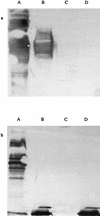Identification of the perosamine synthetase gene of Brucella melitensis 16M and involvement of lipopolysaccharide O side chain in Brucella survival in mice and in macrophages
- PMID: 9784561
- PMCID: PMC108687
- DOI: 10.1128/IAI.66.11.5485-5493.1998
Identification of the perosamine synthetase gene of Brucella melitensis 16M and involvement of lipopolysaccharide O side chain in Brucella survival in mice and in macrophages
Abstract
Brucella organisms are facultative intracellular bacteria that may infect many species of animals as well as humans. The smooth lipopolysaccharide (S-LPS) has been reported to be an important virulence factor of these organisms, but the genetic basis of expression of the S-LPS O antigen has not yet been described. Likewise, the role of the O side chain of S-LPS in the survival of Brucella has not been clearly defined. A mini-Tn5 transposon mutant library of Brucella melitensis 16M was screened by enzyme-linked immunosorbent assay (ELISA) with monoclonal antibodies (MAbs) directed against the O side chain of Brucella. One mutant, designated B3B2, failed to express any O side chain as confirmed by ELISA, Western blot analysis, and colony coloration with crystal violet. Nucleotide sequence analysis demonstrated that the transposon disrupted an open reading frame with significant homology to the putative perosamine synthetase genes of Vibrio cholerae O1 and Escherichia coli O157:H7. The low G+C content of this DNA region suggests that this gene may have originated from a species other than a Brucella sp. The survival of B. melitensis mutant strain B3B2 in the mouse model and in bovine macrophages was examined. The results suggested that S-LPS or, more precisely, its O side chain is essential for survival in mice but not in macrophages.
Figures





Similar articles
-
Brucella melitensis 16M: characterisation of the galE gene and mouse immunisation studies with a galE deficient mutant.Vet Microbiol. 1999 Feb 23;65(1):21-36. doi: 10.1016/s0378-1135(98)00281-8. Vet Microbiol. 1999. PMID: 10068125
-
Role of the Escherichia coli O157:H7 O side chain in adherence and analysis of an rfb locus.Infect Immun. 1996 Nov;64(11):4795-801. doi: 10.1128/iai.64.11.4795-4801.1996. Infect Immun. 1996. PMID: 8890241 Free PMC article.
-
Brucellosis vaccines: assessment of Brucella melitensis lipopolysaccharide rough mutants defective in core and O-polysaccharide synthesis and export.PLoS One. 2008 Jul 23;3(7):e2760. doi: 10.1371/journal.pone.0002760. PLoS One. 2008. PMID: 18648644 Free PMC article.
-
Cloning, nucleotide sequence, and expression of the Brucella melitensis bp26 gene coding for a protein immunogenic in infected sheep.FEMS Microbiol Lett. 1996 Jul 1;140(2-3):139-44. doi: 10.1016/0378-1097(96)00169-3. FEMS Microbiol Lett. 1996. PMID: 8764475
-
The genome of Brucella melitensis.Vet Microbiol. 2002 Dec 20;90(1-4):587-92. doi: 10.1016/s0378-1135(02)00238-9. Vet Microbiol. 2002. PMID: 12414174 Review.
Cited by
-
Whole-genome sequencing of rough Brucella melitensis in China provides insights into its genetic features.Emerg Microbes Infect. 2020 Dec;9(1):2147-2156. doi: 10.1080/22221751.2020.1824549. Emerg Microbes Infect. 2020. PMID: 32936049 Free PMC article.
-
Characterization of an Escherichia coli O157:H7 O-antigen deletion mutant and effect of the deletion on bacterial persistence in the mouse intestine and colonization at the bovine terminal rectal mucosa.Appl Environ Microbiol. 2008 Aug;74(16):5015-22. doi: 10.1128/AEM.00743-08. Epub 2008 Jun 13. Appl Environ Microbiol. 2008. PMID: 18552194 Free PMC article.
-
Importance of Lipopolysaccharide and Cyclic β-1,2-Glucans in Brucella-Mammalian Infections.Int J Microbiol. 2010;2010:124509. doi: 10.1155/2010/124509. Epub 2010 Dec 1. Int J Microbiol. 2010. PMID: 21151694 Free PMC article.
-
Lipopolysaccharide biosynthesis and traffic in the envelope of the pathogen Brucella abortus.Nat Commun. 2023 Feb 17;14(1):911. doi: 10.1038/s41467-023-36442-y. Nat Commun. 2023. PMID: 36806059 Free PMC article.
-
Brucella spp noncanonical LPS: structure, biosynthesis, and interaction with host immune system.Microb Cell Fact. 2006 Mar 23;5:13. doi: 10.1186/1475-2859-5-13. Microb Cell Fact. 2006. PMID: 16556309 Free PMC article.
References
-
- Alton G, Jones L, Angus R, Verger J-M, editors. Techniques for the brucellosis laboratory. Paris, France: INRA; 1988.
-
- Altschul S, Gish W, Miller W, Myers E, Lipman D. Basic local alignment search tool. J Mol Biol. 1990;215:403–410. - PubMed
-
- Baldwin C L, Winter A J. Macrophages and Brucella. In: Zwilling B S, Eisenstein T K, editors. Macrophage-pathogen interactions. 1st ed. New York, N.Y: Marcel Dekker, Inc.; 1993. pp. 363–380.
-
- Bastin D A, Reeves P R. Sequence and analysis of the O antigen gene (rfb) cluster of Escherichia coli O111. Gene. 1995;164:17–23. - PubMed
Publication types
MeSH terms
Substances
Associated data
- Actions
LinkOut - more resources
Full Text Sources
Other Literature Sources
Molecular Biology Databases

